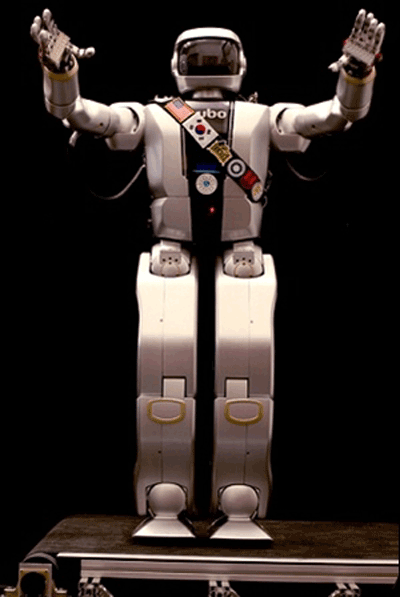During National Engineers Week, Drexel University Makes Robotic History
For the first time, seven humanoids share the stage with one another
Drexel University’s College of Engineering kicked off this week’s National Engineers Week with an unprecedented event: seven adult-sized humanoids — human-like robots— shared the stage with one another, marking the first time in which that many humanoids were ever together in a single setting.

HUBO humanoid presented at Drexel’s National Engineers Week.
The robots each measure 4 feet, 3 inches tall. They all have have joints and are capable of producing human-like movements with arms, legs, and hands, the latter of which include fully functioning fingers and opposable thumbs. The robots were brought in from the College of Engineering’s research partner, the Korea Advanced Institute of Science and Technology’s HUBO Lab, in bits and pieces starting in 2009, with the last three arriving at Drexel earlier this month.
A little history on how this all came about
Dr. Paul Oh, head of Drexel’s Mechanical Engineering and Mechanics department and the one responsible for starting the initial HUBO robot research in 2008, brought over the first humanoid robot, named Jaemi HUBO, in the spring of 2009 as part of an NSF PIRE grant (National Science Foundation Partnerships for International Research and Education).
“Humanoids provide an exciting and practical context to both motivate and train American students,” Oh said. “One can argue that humanoids are the epitome of what one perceives to be a robot. As such, they are an attractive area for engineering students to work on. Students quickly learn that Asia is the world leader in humanoid design. Thus to become humanoid designers, students recognize that working alongside robot engineers in Asia is important.”
With this being the foundation of his thinking, Oh’s students were able to travel to Korea to work with the HUBO lab’s robot platform and learn how to program and operate robots there. Over the course of learning about these machines, students also pursued projects to enable the bots to interact more naturally with humans. One project, in particular, saw students from Drexel’s Music, Entertainment, Technology Laboratory (MET-lab) introduce unique algorithms that directed Jaemi HUBO to dance to music, play the piano, and accompany music with a tambourine, all in an effort to make the machine musically aware.
In August 2010, the NSF awarded a $6 million grant to a group of educational institutions, led by Drexel, to further advance humanoid robotics research in the United States. This Major Research Infrastructure (MRI) grant is what allowed the six additional HUBO units to be brought to the United States for this week’s event.
A few hundred heads are better than one
A major benefit to having multiple identical robots in one setting is that it allows for comparitive research in a single setting, a rarity in such an expensive area of study.
“One of the problems with this level of robotics is these guys are so expensive that most people can’t afford them. The ones who do work with them usually create and develop their own, but they’re all different designs,” said Youngmoo Kim, associate professor of electrical and computer engineering, assistant dean of media technologies in the College of Engineering, and director of the MET Lab. “By bringing seven robots here and standardizing the research, now everyone is studying on a level playing field. Now, it’s a very apples-to-apples comparison.”
Just how human are these humanoids?
For starters, these humanoids can’t see, hear, talk, or feel. But as any engineer will tell you, this is where the fun starts. The teams plan on outfitting these machines with cameras, microphones, and tactile sensors to allow them to sense the world around them.
“Robots, right now, can’t handle this world of humans, designed by humans,” Kim explains. “If we want our robots to eventually be true, assistive robots — doing dishes, putting them away, helping someone who is elderly or handicapped — they need to be able to do the things humans can do. Hopefully at some point in the future, we’ll get there.”
Kim points out presentations like the ones they’re seeing during National Engineers Week allow engineers to come together in a collaborative environment to not only display the field’s research and its benefits to the general public, but also get together and discuss how best to move the field forward. The humanoid presentation is a perfect example, and he is particularly excited by the prospects of what this technology has to offer.
“Robots have already changed the field of manufacturing, but the robots in those factories don’t experience the world like humans do,” Kim adds. “We are envisioning a world where robots can help everyday people in their daily lives.”
What’s next?
Researchers from the seven collaborating schools (MIT, Carnegie Mellon, Virginia Tech, University of Southern California, Ohio State, Purdue and Penn State) will work with the folks at Drexel and receive training on how to operate these robots. Eventually, each bot will be sent off to each school so that researchers can work directly with the machine, while continuing to collaborate with their counterparts across the country.
“Our partners represent a critical mass of humanoid research and brainpower, and this effort will, for the first time, enable researchers to work with a common instrument,” Kim concludes. “Building upon the unique expertise we have developed at Drexel in assembling and maintaining HUBO, this project will rapidly advance the state of the art in humanoid robotics research.” ■
Resources for this story via:
drexel.edu/engineering/news/archive/2012/RoboticsAtDrexelTheCenterpieceForEngineersWeek
Advertisement
Learn more about Electronic Products Magazine





